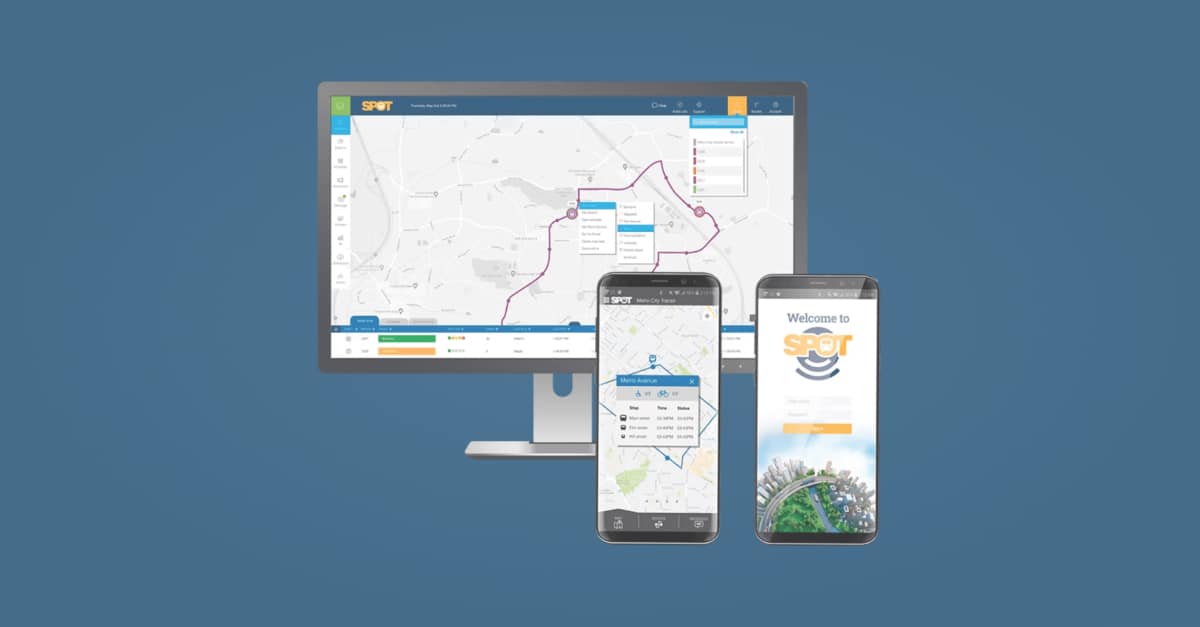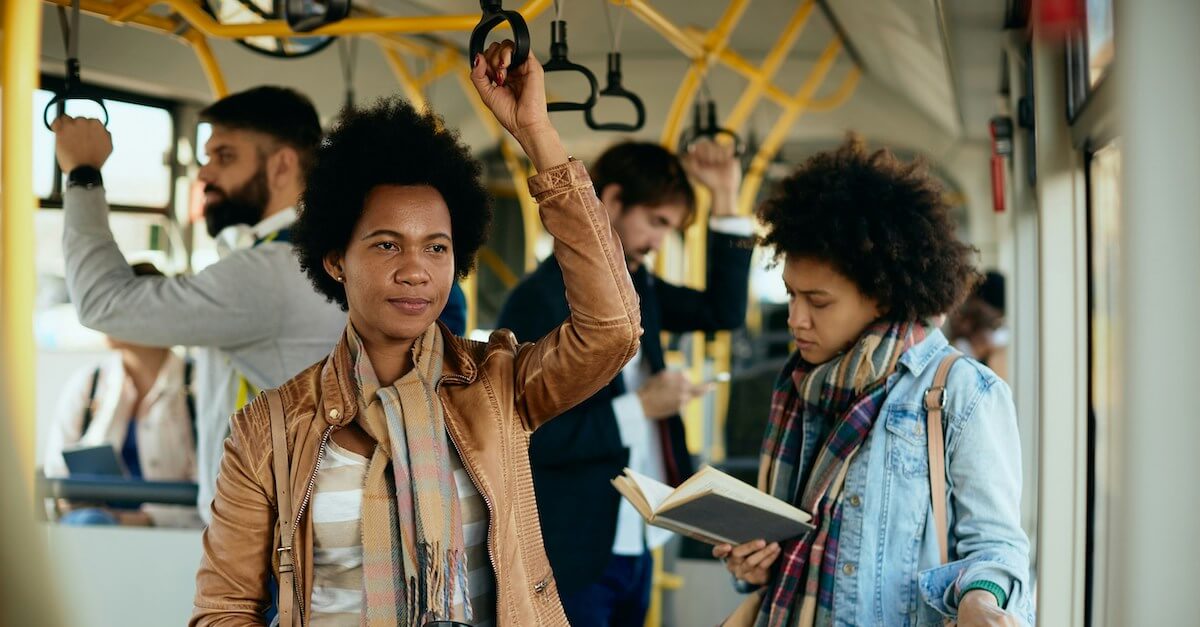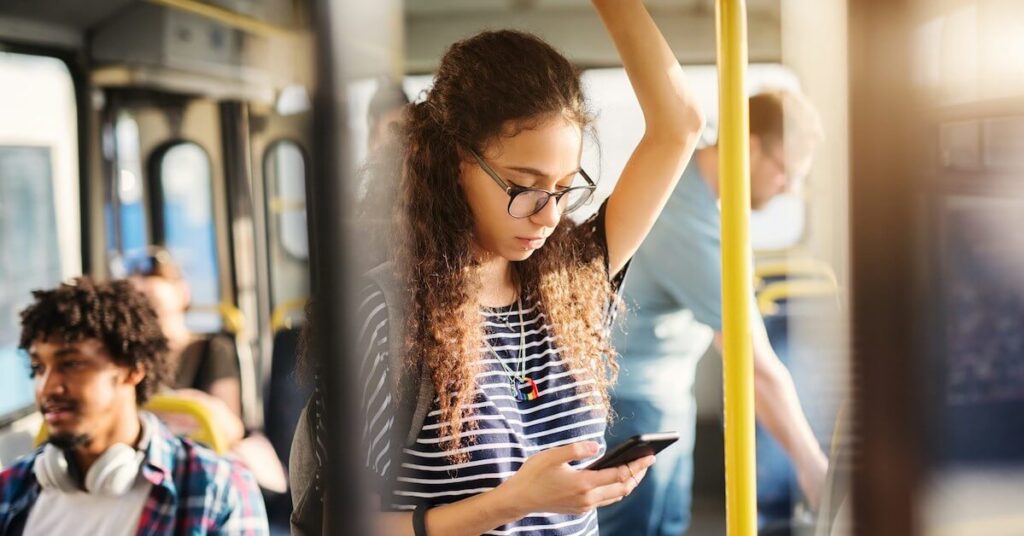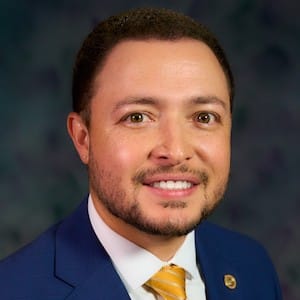I’m your co-host, Levi McCollum, Product Manager at ETA Transit. And I’m your co-host, Christian Londono, Senior Customer Success Manager at ETA Transit. For today’s show, I wanted to focus on an article that was recently posted on Mass Transit Magazine.
It was posted on June 4, and it was titled, Editor’s Notebook, How to Measure Transit and Security. And some of the statistics in this article really caught my attention, and I thought it was important for us to discuss them.
The first one is that one in four adults in the US experience transportation and security. So one in fourth adults have that insecurity or how to get around. So just wanted to stop there and then ask you, what do you think about that statistic and how it relates to maybe the properties in terms of transit agencies where you work or just your overall experience?
And just wanted to get your thoughts on that for us to get started in this conversation. Yeah, I think this is a good topic to bring up. You know, one in four seems pretty profound. I didn’t know the actual statistic, but having worked in the industry for a decade, you see that at a transit agency on a daily basis, right?
People who may have access to public transportation, meaning that they live within a walkable distance or within access to a transportation stop, they are still at a disadvantage, especially when it comes to bus frequencies.
You know, some people who, you know, may have, they may not have access to public transportation and they’re forced to find other ways to be able to, you know, go about their day and go to work or go to grocery shopping.
You know, they are not always in a safe spot because some folks, especially if you’re working class or depending on your socioeconomic status. If your car breaks down, you know, or if you’re riding with a friend and they’re not able to pick you up that day, you know, those become very dire situations where you’re not able to provide for your family or, you know, provide for yourself if the person is living alone.
You know, everything in our society is built on being able to move. And unfortunately, we’ve made it really hard to be able to move around American cities. Yeah, and you know, now that you mentioned that one of the things that came to my mind is that it might also be a cause for homelessness.
I don’t have any statistics on that, but just reflecting on being able to have access to opportunity to be able to get to work, to be able to do the things that you need to do out there. And then if now, if that becomes crippled, limited, or even where you are located, you know, the transportation is really limited.
It puts you in a really bad spot that might even lead to homelessness. And, you know, I’m tying that also to, you know, the fact that people in the U.S. that you know, this challenging economy climate we’re in have chosen to live in their cars, have chosen to lose their home, but keep their means of transportation.
And I’ve known of actually bus operators that live in their cars and that pretty much move their home into their cars because they don’t have a home anymore. But the other part that I wanted to bring up in terms of interesting statistics is that more than half of adults in the U.S.
who are experiencing poverty are also experiencing transportation and security. So back to, you know, maybe tying it to homelessness or experiencing challenging, you know, economies and how when people are in that position where they don’t have enough money, maybe that’s why they cannot afford to pay for a mortgage or for, you know, pay for rent and pay for their, you know, the transportation or their car,
they choose to have the card and, you know, some of those that are not able to have a car or don’t have a car, they’re, you know, part of that more than half of adults in the U.S. that are transportation insecure.
So, it’s also very interesting to take a look at how it happens by location. You know, the article also provides a breakdown percentage-wise of where this happens. 13 percent are rural residents, 22 percent suburban residents.
And to me, the highest number in alarm, and yes, the urban areas are more dense, but 39 percent of urban residents are transportation insecure. And I would think that the urban systems should be more robust to be able to allow for folks to get around but you know my perception is that maybe those systems are not robust enough to make sure that people have access.
Yeah that’s interesting you know I think in the last few decades our cities have changed quite a lot. Probably one implication of that is or at least a signal that they have changed is that the transit service is getting better in the suburbs rather than focusing on the downtown urban centers which have traditionally had better public transportation options.
One thing that I find kind of fascinating right now is that there are a lot of folks younger folks especially who are moving into urban areas and as they start to move into the urban areas they become higher priced right.
The homes increase in value and rent goes up. As a result that does push some folks who are you know maybe at that poverty line or below out of those areas that they were in and the downtown before. So could we eventually see where folks who are maybe below the poverty line or at it maybe slightly over be pushed out to the suburbs where right now the transit service is better than it was before but would that trend reverse?
You know is transit following the money really you know and that seems to be serving people who might not necessarily need the public transportation as much. I mean that’s my take on it. and it’s hard to put your finger on it right like that that’s where you know we were talking about our perceptions in what we believe might be contributing factors and you know something that is interesting to point out is in february 2023 the federal transit administration awarded a six million grand to university of minnesota to design a program they call it maddie mobility access and transportation security to identify the contributing factors leading to transportation security and also very interesting in in the same article it points out that even the cdc came up with an analysis where they showed a you know the health outcomes associated with the lack of transportation access.
So even at the CDC level, they’re looking at that. But most importantly, the FDA is partnering with the University of Minnesota to be able to analyze and determine how it can be measured, how to study that transportation security, that access to school, to work, to social activities, and how when all the agents are reporting their numbers or just looking at the data, they could learn on how to assess this and their communities as well,
to make sure that we’re not just on time or we’re reporting how many people are getting on the bus and when we’re conveying the value of transit to elected officials and different stakeholders, we’re just not talking about how many people were moving per hour and hours of service and how many miles, but we’re able to actually show them the value in terms of that access to transportation.
And the important study plays in the economy, right? To your point, to what you were saying, a lot of people have to move to other places just because where they’re living is becoming every day more and more unaffordable.
And if you’re at or below the poverty level, you have a minimum wage job and your rent is being increased, you’re being pushed out of that urban area and maybe into the suburbs or other places, but those folks go to work, those folks are trying to go to school to be able to better themselves and get higher paying jobs.
So it’s important in, I guess, from the federal level that agencies or the industry as a whole is looking for these factors. They’re trying to study that access to transit as a whole. Yeah, transportation unlocks opportunities, not just public transportation.
like what you and I are most familiar with and have worked in for 20 plus years combined, transportation overall is a way to be able to serve your needs in society. It’s the opportunity to be able to participate in social activities and societal activities, things that are that are bigger than just you, the economy at the micro and the macro level.
If you don’t have access to transportation, then you’re probably not going to be able to participate. It leads to a lot of isolation. You might only be able to afford or have access to transportation to be able to go to your job and an example of someone that may be carpools.
Right. How else are, is that person going to be able to socialize, to meet with family and friends? I think about the mental well-being of the people who are perhaps stuck in that position where, you know, it’s basically day in, day out, you’re struggling to be able to meet those very basic needs.
And if you look at Maslow’s hierarchy of needs, you know, you have to be able to serve the most basic ones first, right? Food and shelter. And in this case, to be able to get food and shelter, you have to have transportation.
So I think that’s absolutely right. You know, transportation sits in the middle of that. I think, you know, it highlights the need to be able to invest more in our community’s transportation options, specifically public transportation, which has received so little of the share in the past.
And we probably would see more equal or at least equitable outcomes if we were to invest more in public transportation. Yeah. And the other factor is that, you know, we look at the access to transportation.
There’s areas in our communities that don’t have transportation. As transit agencies are trying to find ways to serve the communities they serve, they have to prioritize areas that are more likely to generate ridership.
You know, you’re trying to benefit the most people, the higher amount of people in your community, those people below the property level or at the poverty level that might need the system the most. But the other part is, so it’s not just the contrast between the areas that you serve where there’s a transportation option.
and the ones that don’t have any transit around, but it’s also the quality of the transportation options that are available. So I wanted to bring up this definition to further discuss this topic. It’s from the Mineta Transportation Institute and they define transit insecurity.
And like I was saying, in my mind at the beginning, transit insecurity is like, well, where there’s transit, where there’s no transit, where there’s no transit, there’s transportation insecurity because if you don’t have a car, how do you get around?
But their definition says that it is the inability to consistently access or afford a reliable transportation system leading to a demonstrable negative impacts on a person or community. persons and communities experiencing transit insecurity may directly perceive these negative effects, though they also may not.
And they said that the factors that contribute to a personal community being transit insecure are first income level. So those folks that, you know, are at the property level, may be below, and for them, you know, getting their own personal way of getting around, maybe buying a vehicle is not an option, is unaffordable.
They’re definitely there. But the second one, they talk about travel distance. So, you know, where you are located in relation to the places where you might need to go. Third is the travel duration. So again, I’m kind of like reading these factors so we can go through them, but, you know, travel duration, talk about frequency and then the time that it takes to get from point A to point B on transit.
And the fourth one is accessibility. So how accessible it is in, you know, I believe that’s more also from the ADA standpoint. So all those communities that might be ADA, and then they have that accessibility challenges.
You know, we have communities with roads, with no sidewalks, with, you know, no accommodations for folks with disabilities. So how can they access transit there? So going back to the transit system, and let me ask you this question.
Based on that definition, what aspects do you think within an agency’s transit service might need improvement to address transit insecurity? Yeah, I think for some agencies that they’re maybe ahead of others in this, but making some parts of their service more dynamic, right, you might have a public transportation fix route.
that’s somewhat near your home but is relatively inaccessible. Maybe the lack of sidewalks, maybe it’s just not a hospitable walking environment to get to public transportation. I mean certainly in Florida we can see many examples of this.
Some agencies have implemented more on-demand type systems to be able to feed those fixed route lines or the trunk lines. I think that there’s a lot of good ideas and innovation there. I wonder how much of it though is how much it’s going to cost the communities to be able to supplement their service in this way and still maintain the fixed route lines because you don’t want to rob Peter to pay Paul and go to a completely on-demand system in most cases.
Maybe in some more rural communities that makes sense but I think in a you know, for most communities in the United States, you probably want to have a mix where you’re providing some on-demand services in the areas that have more of your dense suburban, even though that’s a little bit of an oxymoron, but some denser suburban environments that can then feed into a more frequent fixed route line.
So I think that’s what we’ve seen over the last several years, certainly with VIA and RICO and a few other players in this space. Yeah, and I think- What are your thoughts? Well, those innovative solutions are addressing those different type of service areas, right?
Like, you know, I like how you pointed out, in some communities, you need to have those kind of micro mobility that are feeding into the main fixed route lines and giving folks in those areas access to the overall system, you know, creating that connectivity.
But I also was thinking about the, you know, the quality of the service, right? University of Minnesota simplified that definition and they said that transportation security is the experience of being unable to move from place to place in a safe or timely manner.
And I think time is very important. When you talk about frequency and frequency is freedom, you know, I believe that you said that earlier and, you know, how can agencies invest in increasing that frequency to make sure that it works in terms of timing for people, but also the travel times.
If traveling in public transit, you know, just regular bus service, it takes you three, four, five times then driving, then what’s the quality of that system? timely manner to get around. Think about that you’re trying to get to work and maybe go back to transportation security.
So maybe there’s a transportation option. There’s a fixed rail system that is serving that community right there. But the timing and how long it takes to get from point A to point B, to get to that job is so poor that it’s not sustainable, that it just cannot be traveling almost three hours, two hours every day, each direction to try to get to work.
And then if I want to make sure that I’m on time at work, then I have to make sure that I’m taking those earlier trips. So that’s the part that I’m thinking that even though those folks have an option, they can write that fixed rail line or they have an option.
In a way, they’re also considered transportation and secure because the quality of the transit that is available is not sufficient to meet their needs. It’s impacting their daily lives. And therefore, agencies, although they have to look at the service area, a lot of communities are growing and they have to be some service changes to address the growth and maybe a new route to get to that newest community that is being developed,
but it’s also looking at the areas that we’re serving. We look at that ridership and coverage tradeoff in where sometimes the coverage is just give a little bit of transportation to everybody out there so they have a little something.
And then we think that that’s sufficient. And we, a lot of times in communities, choose that over ridership because that way we feel that we’re politically correct, like everybody’s getting a little bit of everything.
But that coverage is really also a little bit transportation and security because those folks are not getting that safe and timely transportation in their community. Yeah. And I think if you dial it completely the other way, we’ve gone more towards the coverage oriented approach.
If you turn the dial the other direction and went all ridership, then you’re going to end up with a lot of people who are in the suburban and rural areas who don’t have any access to public transportation, which is not what you want.
There certainly has to be some blending there between the coverage and ridership. And for each community, it’s going to be what fits them best, what their transportation network is, specifically the road network and how their urban land use pattern has played out over the last few decades, what type of urbanization rate that they have, or people that are in the rural people becoming more suburban?
Are they moving into the downtowns? Population is a big portion of it. The demographic, those socio-demographic understanding that you have to have to be able to plan the transportation service really comes into play here.
Certain folks are more inclined to use public transportation than others. And I think that that needs to be considered. Yeah, that’s a great point. And I think when you’re looking at ridership versus coverage, what limits being able to provide a network that is high coverage, high ridership is the resources, is the investment, right?
That you have limited resources, so you cannot serve every community that that is out there in your community with a high frequency network because that’s that’s expensive and also you’re looking at at efficiency right like you you want to make sure that the system is efficient that you know is a good amount of people that you’re transporting for revenue hour so it’s not just a providing some access and having a system in place that give people an option but is not being utilized.
You know, utilization it is important but at the same rate it to me it just speaks to the you know importance of investment of public transit and if this number one of four adults in the u.s experience transportation and security i just think that that that statistic is loud enough to call for more investment in public transit.
So I’ll be keeping a track on what’s happening with this this developing and what comes up of the mobility access and transportation security program from the university of Minnesota and how transit agents around the country can really put their fingers on the pulse of what’s happening with you know transportation security and and hopefully provide some guidelines on how we can all tackle that around the country.
All right, Christian, well this has been a great conversation. I’ve really enjoyed it I hope our listeners have been able to follow along with the conversation and you know feel free to give us any feedback did we get anything right did we get some things wrong please let us know, and we’ll be back next week with another episode of Stop Requested.

SPOT: ETA’s Core Platform The SPOT™ ecosystem offers transit management solutions by providing a flexible, modular platform.
All Solutions
CAD / AVL / GPS tracking
Business intelligence
Digital signs and kiosks
Infotainment
Automatic passenger counting
Tally NTD Survey Software
Tracking websites and apps
Vehicle announcements
Vehicle health monitoring (AVM)
Voice communication





